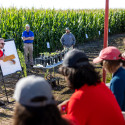New technology provides real-world data for distance athletes
Professional athletes, including cyclists and distance runners, soon will have a powerful new tool to predict energy expenditure and performance during a race, thanks to a collaboration between the UW and Saris Cycling Group of Madison. The technology also has potential medical applications, including helping to treat obese children and adults and cardiac patients.
“This is a unique collaboration that takes studies that were previously done in the lab out into the real world,” says Jeff Sledge, who began the project as part of his work on a Ph. D. in land resources from the university’s Gaylord Nelson Institute for Environmental Studies.
The new technology was conceived at the Land Information and Computer Graphics Facility in the College of Agricultural and Life Sciences, where Sledge is an outreach specialist. Saris Cycling Group, a local cycling gear manufacturer, provided equipment and expertise to Sledge and his colleagues.
And while additional research and analysis continues at the LICGF, Saris is poised to spin the technology off into an innovative tool for distance athletes. “As a result of the collaboration with CALS, we’re rolling out a new product that will be tested during the Tour de France in June and July of 2005, and will hopefully be available commercially in August,” says David Cathcart, director of marketing for Saris.
“The benefit to our company of the partnership with CALS has been phenomenal,” Cathcart adds. “The brainstorming with Jeff and others has opened our eyes to new possibilities for our products, and it’s been invaluable to bounce ideas off of experts.”
Their collaboration began when Sledge became interested in using geographic information systems – collections of computer software and hardware that display attributes of a landscape like elevation and population density – to make predictions about how people might use an area.
“We want to take large streams of data as input, observe the change as it happens and make forward predictions,” he explains. Sledge and his colleagues developed a new temporal-spatial data model that extends the power and usefulness of GIS to a broad range of applications that seek to analyze complex environmental processes as they are happening.
Sledge designed a project to test his idea using a bicyclist as the source of data. He outfitted a bicycle with a global positioning system unit and special Cycleops Powertap wheels provided by Saris, which record a rider’s heart rate, the wattage and torque of the bike, the energy expended and the cadence of the wheel revolutions. Sledge, a triathlete and former racing cyclist, then pedaled his “rolling laboratory” for thousands of miles around south central Wisconsin.
The rides resulted in millions of pieces of data that when combined with existing information about the landscape of the route painted a detailed picture of Sledge’s performance during the ride – and showed why high-performance athletes might find such technology useful.
“If you know the route, as in the case of a road race, and you know what finish time you’d like to have, you could calculate in advance how much energy you will need to expend,” Sledge explains. “As the race progresses, you can find out when you need to eat to replenish your energy, when you need to go faster to make your goal and how much energy you have left to burn. You can even balance efforts among members of a race team.”
Beyond racing and athletic uses, Sledge predicts a broad range of applications for his research, which he hopes to complete within the next two years.
“Our next step is working with this technology to address the needs of underserved and at-risk populations, especially groups containing obese children or children who might tend toward obesity,” Sledge says. “We’re going to study energy expenditure both in the lab and in a real urban environment, and ultimately establish an information baseline for clinicians.”
With a better understanding of how much energy a person – an overweight 10-year-old, for example – actually uses as he or she moves through a typical urban environment, a doctor might be better able to recommend daily activity levels to improve fitness. Similarly, combining knowledge of energy expenditure with existing information about a landscape might help a physician recommend an appropriate exercise route to a patient recovering from a heart attack.
Beyond athletic and medical applications, the research has a wide range of potential uses, says Sledge. For example, communities could use it to plan the best paths for bicycle commuters, minimizing stresses to avoid having riders arrive at work exhausted, or researchers could predict the movements of migratory animals, free-range cattle or wolves as they prey on herds of elk.
Tags: research




